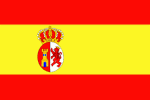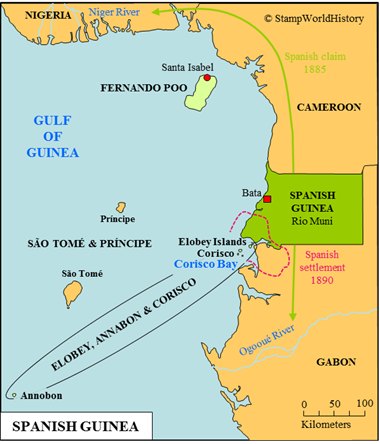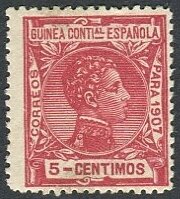
Spanish Guinea
Note: In the Michel catalog the major entity of Spanish Guinea covers the period of the existence of the colony of Spanish Guinea as a separate stamp issuing entity from 1902 to 1909. Issues for its successors until 1959 are listed under the separate major entity of the Spanish Territories in the Gulf of Guinea. Scott, Stanley Gibbons and Yvert & Tellier list all the issues from 1902 until 1959 under the major entity of Spanish Guinea. As I follow the Michel catalog in the definition of major entities e.g. countries you will find two separate profiles on this site, one for Spanish Guinea and one for the Spanish Territories in the Gulf of Guinea.
Quick reference
General issues: Spanish colony 1902-1909
Country name on general issues: Guinea Española, Guinea Continental, Guinea Contial Española
Special issues: Local issues Bata 1901
Currency: 1 Peseta = 100 Centimos 1902-1909
Population: 154 000 in 1910
Political history Spanish Guinea
Spanish Guinea is located in central Africa on the Gulf of Guinea. The first Europeans to explore the Gulf of Guinea are the Portuguese in the 1470’s. The Portuguese settle on a number of islands in the Gulf and claim the rights to the coastal region on the mainland, from the Niger River to the Ogooué River. By treaties in 1777 and 1778, the Portuguese trade part of the islands and the claim to the mainland with the Spanish for territories in the Americas. The Spanish, however, do not establish a permanent presence in the region until the 19th century.
As the ‘Scramble for Africa’ required the colonial powers to assert their authority over their rights – or claims – to the African continent, the Spanish took a new interest in their possessions in the Gulf of Guinea. The Spanish settled on the islands of Fernando Poo and Annobon. The Spanish claim to the mainland was discussed at the Berlin conference in 1885 where the colonial powers divided their respective spheres of interest in Africa. At the conference, the territory known as Rio Muni was awarded to Spain – a small part of the territory claimed by Spain based on its treaties with Portugal. The Spanish, subsequently, in 1885 established the protectorate of Spanish Guinea. By 1890, the Spanish had established themselves around the Corisco Bay, including Corisco Island and the Elobey Islands. Extended negotiations with the French led to finalization of the borders in 1900, upon which the protectorate became the colony of Spanish Guinea with Bata – at the time a military garrison – as its capital. Corisco and the Elobey Islands were made part of the separate colony of Elobey, Annobon & Corsico, also established in 1900.
Spanish Guinea was populated by the Fang, a Bantu people. Spanish Guinea was brought under effective Spanish control in the first part of the 20th century – a process that would take until 1926. As Spanish colonial administration was more and more established, the colony was also developed economically, mainly through the setup of cocoa plantations.
In 1909, Spanish Guinea became part of the Spanish Territories in the Gulf of Guinea, together with the colonies of Fernando Poo and Elobey, Annobon & Corisco. In 1926, the separate colonies were de jure integrated into one colony also called Spanish Guinea. The Spanish possessions, in subsequent years, went through a number of administrative changes to gain independence as the republic of Equatorial Guinea in 1968. Currently, the former colony of Spanish Guinea, as it existed between 1900 and 1926, is the Mbini region of Equatorial Guinea.
Postal history Spanish Guinea
The first stamps used in the Spanish settlements around the Corisco Bay were the stamps of Fernando Poo. In 1901, stamps from Fernando Poo were overprinted ‘Bata’ or ‘Habilitado para 10 cents Bata’. These are referred to by Michel and Yvert & Tellier, but not listed. In 1902, the first set of definitives was issued for Spanish Guinea – a set with the portrait of king Alfonso XIII. Further sets of definitives follow until 1907. Several sets of provisionals are issued – also on revenue stamps and on stamps issued by Elobey, Annobon & Cosrisco.
The stamps of Spanish Guinea are, from 1909, superseded by the issues of the Spanish Territories in the Gulf of Guinea – please see the note above. These were superseded by the issues for Rio Muni from 1960. Currently in the territory the stamps of Equatorial Guinea are used.
Album pages
← Previous page: Southern RhodesiaNext page: Spanish Morocco →



